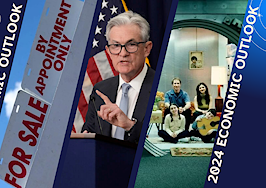The verdict is in — the old way of doing business is over. Join us at Inman Connect New York Jan. 23-25, when together we’ll conquer today’s market challenges and prepare for tomorrow’s opportunities. Defy the market and bet big on your future.
The architect of New York City’s “doom loop” scenario says the city seems to be avoiding the apocalyptic future he once laid out for it.
Columbia Business School professor Stijn Van Nieuwerburgh, whose 2022 academic paper inspired a flurry of foreboding headlines about New York City’s “urban doom loop” says things now seem to be looking up for New York, despite his prediction that less demand for office space would send it spiraling.
In an interview with the New York City news website Gothamist, Van Nieuwerburgh noted that New York’s economy has proven itself to be well-rounded enough to weather the storm posed by decreased office vacancy, especially when compared to how other big cities are handling similar problems.
“New York City is recovering to a better extent than most large U.S. cities. And I think that has to do with the fact that New York City’s economy is a well-diversified economy,” he told Gothamist.
Van Nieuwerburgh drew a contrast to San Francisco, where the tech-dominated downtown has been all but hollowed out of office workers, leading to an eerie sense of societal decay in the business district.
“San Francisco is spiraling further downward,” he said in the interview. “We have a lot of different sectors, whereas San Francisco is fairly tech-dependent.”
Van Nieuwerburgh first explored his “urban doom loop” scenario in his 2022 paper “The Remote Work Revolution: Impact on Real Estate Values and the Urban Environment.” In the paper, he argued that if white-collar workers continue to work at home instead of in business districts, the resulting loss of billions in value for office buildings could force cuts to be made to essential social services such as public transportation, education and housing that could cause further social problems, causing even more white-collar workers to stay home — the “loop” in the doom loop.
But over a year later, many of Manhattan’s business districts are bustling during workdays, thanks in part to return to office mandates. Van Nieuwerburgh specifically cited the financial sector for aiding in the city’s recovery by having the majority of its employees return to the office.
He also noted that New York’s reputation as a buzzy nightlife city that young people actively want to move to gives it a major advantage over other cities.
“We have a lot of young people that want to be here. They want to go to the bars and to the clubs and all that jazz,” he said. “I think the fact that New York City continues to attract those young people, those 22- to 25-year-olds, because of its vibrancy is what really sets our city apart.”
But it’s too soon for the Big Apple to declare victory over urban decay he said, as budget cuts and its severe housing shortage threaten its already fragile vibrancy. Van Nieuwerburgh said he supports office-to-residential conversions to create more housing supply.
“And at the end of the day, we want to create vibrant neighborhoods, and vibrant neighborhoods require housing,” he said. “Whenever a building is amenable to it, I think that conversion from office to residential should be our first choice.”













